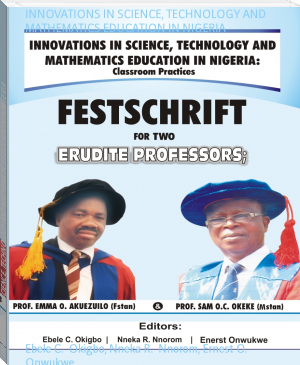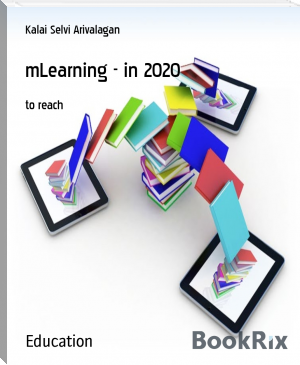INNOVATIONS IN SCIENCE, TECHNOLOGY AND MATHEMATICS EDUCATION IN NIGERIA, Ebele C. Okigbo, Nneka R. Nnorom, Ernest O. Onwukwe [best reads .TXT] 📗

- Author: Ebele C. Okigbo, Nneka R. Nnorom, Ernest O. Onwukwe
Book online «INNOVATIONS IN SCIENCE, TECHNOLOGY AND MATHEMATICS EDUCATION IN NIGERIA, Ebele C. Okigbo, Nneka R. Nnorom, Ernest O. Onwukwe [best reads .TXT] 📗». Author Ebele C. Okigbo, Nneka R. Nnorom, Ernest O. Onwukwe
Government sending teachers to workshops, 3.46 0.73 Agree
seminars and conferences
In-service training 3.33 0.60 Agree
Employing a committed and competent 3.25 0.77 Agree
Teacher
Use of effective methods of teaching 3.20 0.76 Agree
Use of instructional resources 3.26 0.91 Agree
Adequate class size that the teacher can manage 2.81 0.79 Agree
Teachers carrying pupils along with respect to 2.90 0.60 Agree
individual difference
Relating teaching to real life situation 3.14 0.81 Agree
Having a conducive learning environment 3.30 0.74 Agree
Parents keeping track on the performance of 2.95 0.83 Agree
their children
Parents buying the necessary learning materials 2.96 0.76 Agree
for their children
Cluster Mean 3.11 0.76 Agree
Data in Table 2 show the possible solutions to the problems encountered in the teaching and learning of mathematics in primary schools. The respondents agreed that all the items so stated are the possible solutions to the problems encountered in the teaching and learning of mathematics in primary schools. This is confirmed with the mean scores of 3.11 with the standard deviation of 0.76.
Discussion
The findings in Table I showed that the factors affecting the teaching and learning of mathematics in primary schools among others include; Government not paying attention to what is happening in the teaching and learning of mathematics, child’s home environment, pupils not grounded in mathematics, large class size, parent’s academic background and pupils having phobia for mathematics. The findings is in line with the study carried out by Ho and Hyun (2011), posits that lack of skills in understanding mathematical symbols, formulas, concepts and representations are challenges experienced by pupils in mastering mathematics subject. These findings are also aligned with the study conducted by Gomez-Charon cited in Machaba (2013) who found out that the emergence of negative attitudes and behaviours towards mathematics are the factors that contribute to the failure in mathematics. When pupils have negative perception towards mathematics such as perceiving mathematics as being too difficult and very confusing to learn, they will quickly lose their interests and motivation to learn the subject. As a result, they cannot perform well in solving mathematics problems. Similarly, Anaduaka and Okafor (2013) posit that teachers are not excluded from the blame of high failure rate in mathematics because of the use of ineffective method of teaching the subject. Most teachers continue to keep fate with the old system of teaching that has nothing interesting or enjoyable to offer to the learners.
The findings in Table 2 revealed that government support through providing free textbooks for pupils, government sending teachers to workshops, seminars and conferences, in-service training, employing a committed and competent teacher, use of effective methods of teaching and use of instructional resources among others are the possible solutions to the problems encountered in the teaching and learning of mathematics in primary schools. In consonance with the above findings of Idowu (2011), who posits that better recruitment and possibility of better selection of teachers is important. Also, better substantive education in teacher training institutions, on the job training of younger teachers by more experienced ones and in-service and long vocation courses to continue the education of teachers are some of the strategies to tackle the challenges. Similarly, the finding is in consonance with that of Adolphus (2011), who posits that the strategies to enhance better teaching and learning of mathematics in schools includes; the teacher should arouse the interest of the learners while introducing the topic, use of instructional material to make the materials real, relate to real life situation, conducive learning environment, and necessary facilities in schools to facilitate teaching and learning. Others include; appropriate method, carrying all learners along with respect to individual difference, make the learners do more practical work than theoretical, class size should be such that the teacher can manage and teachers should monitor the activities and performance of their learners. In addition, Okafor and Anaduaka (2013) are of the view that a successful mathematics teacher must use several methods in one lesson. Various methodologies used in mathematics teaching includes; play-way, project, demonstration, discovery, guided inquiry, problem solving, laboratory, cooperative learning strategy, individualize instruction, team teaching, target task approach, computer assisted instruction and multiple intelligences teaching approach. Also, Shulman cited in Machaba (2013) concurs and further identifies content knowledge, pedagogical knowledge and pedagogical content knowledge as components of the professional knowledge of teachers. This implies that the teacher should not only possess academic knowledge, but should also be able to impact it in an understandable manner. It is vital that the vehicle of the teacher’s thoughts and knowledge should be clear and vivid to the child.
Conclusion
The common challenges faced by the pupils in their daily learning process for the mathematics subject may be pressure coming from teacher, school or family members who place very high expectations for pupils to excel in mathematics. With regard to delivery, mathematics teachers need to consider alternative methods of delivery which can boost pupils’ motivation to continue studying mathematics. Teachers need to make sure that their learners see the value of each mathematical task or activity assigned to them. When the learners appreciate the tasks, they will be more persistence and will be more willing to stay longer in completing the mathematics activities because they noticed the importance of mathematics in their life. In addition, parents need to put more emphasis on encouraging and motivating their children rather than setting very high expectations. Besides, teachers need to be aware of their learners’ individual ability in learning mathematics. The teachers must provide supportive learning environment to allow children to learn comfortably. Learners must be trained to develop a positive attitude and perception towards mathematics. This is very important because their actions are influenced by their thinking. Finally, all the problems and difficulties in learning mathematics needs be addressed properly so that learners can endure in the daily mathematics learning progress.
Recommendations
Based on the findings, the following recommendations were made:
Teachers should increase their knowledge in the teaching and learning of mathematics through in-service training.
Government should provide the necessary infrastructures and facilities that will motivate teaching and learning of mathematics.
Teachers should relate their lessons to real life situation in order to reduce abstract nature of the subject and also for easy understanding of the subject by the learners.
Government should organize workshops, seminars and conferences for the teachers to improve their knowledge on the methods and instructional materials to use in the teaching and learning of mathematics.
Teachers should take care of and consider the slow learners in their classrooms in order to help them in the teaching and learning of mathematics.
References
Adolphus, T. (2011). Problems of teaching and learning of geometry in secondary schools in Rivers State, Nigeria. Int. J. Emerg. Sci, (IJES), 1(2), 143-152.
Anaduaka, U. S. & Okafor, C. F. (2013). Consistent poor performance of Nigerian students in mathematics in Senior Secondary Certificate Examination (SSCE): What is not working? Journal of Research in National Development, (JORIND), 11(2), 1-5.
Betiki, O. F. (2001). Causes of mass failure in mathematics examination among students. A commissioned paper presented to Government Secondary School, Karu, Abuja Science Day. 1st March
Coffey, M. (2011).Raising to numeracy challenges. Adult Learning June 2011
Federal Republic of Nigeria (2014).National Policy on Education. Lagos; Federal Government Press.
Harbor-Peters, V. F. A. (2001).Unmasking some aversive aspect of school mathematics and strategies for averting them. Inaugural lecture, University of Nigeria, Nsukka. Enugu: Snaap Press LTD.
Ho, K. K., & Hyun S. Y. (2011). Development and validation of a mathematics anxiety scale for students. Asia Pacific Education Review, 12, 509-521
Idowu, O. D. (2011). Developing Nigerian integrated science curriculum. Journal of Soil Science and Environmental Management, 2(8), 134-145.
Machaba, M. M. (2013). Teacher challenges in the teaching of mathematics at foundation phase. A Ph.D Desertation,Department of Early Childhood Education, University of South Africa.
National Mathematics Centre (2009). The proceedings of National Mathematics Centre, Abuja www.nmcabuja.org.proceedings
Okafor, C. F. & Anaduaka, U. S. (2013). “Nigerian school children and mathematics phobia: How the mathematics teacher can help”?American Journal of Educational Research, 1(7), 247-25. DOI: 10.12691/education-1-7
HUMANOID APPROACH TO SCIENCE INSTRUCTIONS:
INCREASING LEARNERS’ ENTROPY AND MAXIMIZING LEARNING
Dr. Ernest O. Onwukwe
Abstract
This chapter identifies a missing link between Science, Technology, Engineering and Mathematics (STEM) Education on one hand, Creativity and competitiveness in this twenty first century on the other hand. That missing link is the exclusion of the arts in STEM education. Art forms typified by music, drama, analogies, metaphors, plays, games and even visual arts etc., should all be part of STEM. The call for STEAM education with ‘A’, representing ‘Arts’, should therefore be taken seriously. The arts can therefore be used to bridge the gap between expensive experience and imagery, the key element in conceptualization and still have comparable learner performance in STEM. The paper further discusses conceptualization process in science. Concepts are very important in science teaching and learning so, the process of conceptualization should be thoroughly understood and enhanced by every science communicator. Without imagery, conceptualization will be almost impossible. This chapter deals with how to bridge the gap between ‘actual experience’ and meaningful science concepts. The highlight of this write up is the proposal of a theory of achievement enhancing and gender bias of drama applications in science instructions. Finally, the paper discusses humanoid modelling of science instruction as a strategy of increasing learner cooperation and participation in the classroom. In humanoid modelling of science instructions, the author stresses the importance of making the young learner appreciate the learning content as part of humanity and thereby removing to some extent, the abstractness of some concepts. This is more so for the young learner who is being encouraged to embrace and remain with science subjects enough to make a career from them. The author therefore, explains some of his models of conceptualization, the structure and orientations in science, science instructional strategies, and other experiential science instructional modes like field trips, project works, etc.
Keywords: Humanoid Approach ,Science Instructions, Learners’ Entropy , Maximizing Learning
Introduction
The Missing Link Between STEM and STEAM Education: The Clarion Call.
There is a growing concern that the Arts should also be emphasized in science teaching and learning. “Many people are saying that STEM (Science, Technology, Engineering, and Mathematics) kills science. In fact, some authors argue that there is a crucial missing link between STEM, Creativity and Competitiveness. That link is ‘A’ for Arts and hence the call that science educators should move quickly from STEM to STEAM Education, as a crucial amendment. Without the ‘A’, STEM will remain unattractive and its products will have no outlets in today’s world. This, according to the author, is because the Arts skills in the 21st century appeal to a larger, broader segment of the workforce and studentship than STEM. In supporting the move from STEM to STEAM, Mary, Ramirez, Clement, and Else, (2002) describe creativity as a secret sauce in STEM and sees Arts as the only avenue to a truly creative STEM Education.
According to Wilcox (web page retrieved April 7, 2014 from www.asce.org) there is ample empirical evidence that a strong correlation exists between success in arts and success in STEM subjects and that correlation may arise from the way the brain operates. The author goes on to claim that creativity and experimentation fostered by visual arts and music can play an important role for students who pursue STEM careers. Ramirez (2013) could not agree less when she stated as a research finding that productive thought requires the very important component of play. From the foregoing therefore, we are beginning to narrow down to the true components of the ‘A’ proposed to compliment STEM as far as science education is concerned: Visual arts, music, drama and so on.
Onwukwe (2009) has proposed a technique applicable in science education that will link the arts and science communication. The author referred to the technique as ‘Arts-in-science technique’ and defined it as all planned use of any art form, not traditionally employed in teaching science, be it an activity or a presentation in print, on stage or electronically displayed, through which science is communicated,





Comments (0)